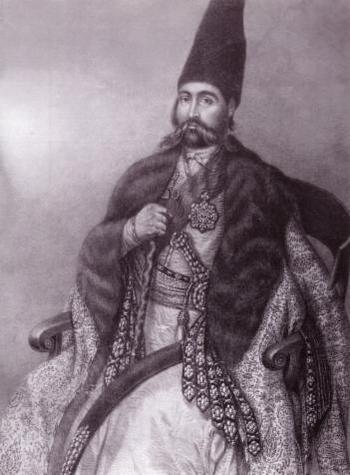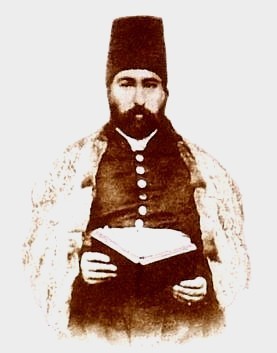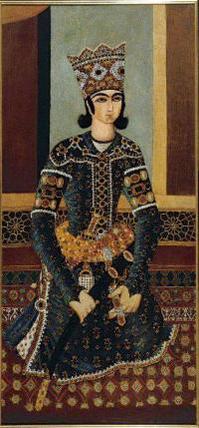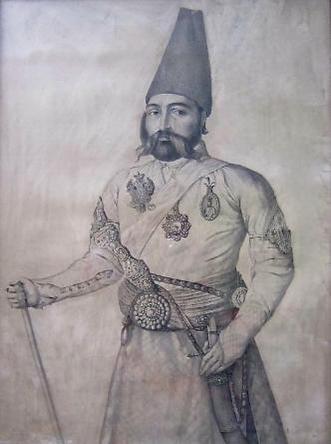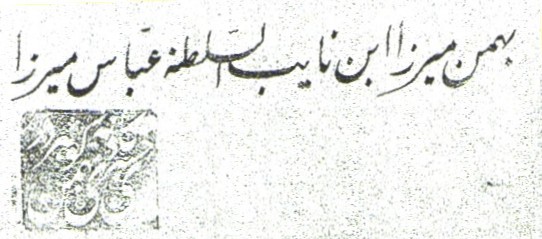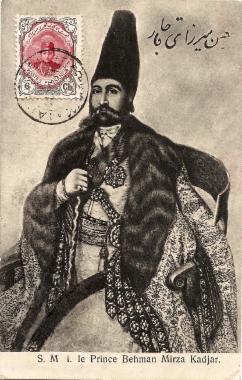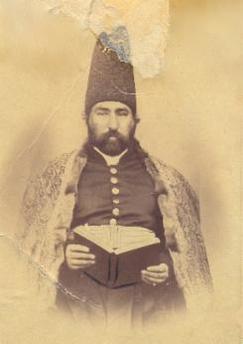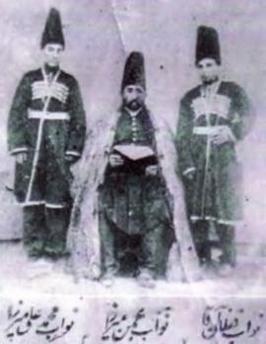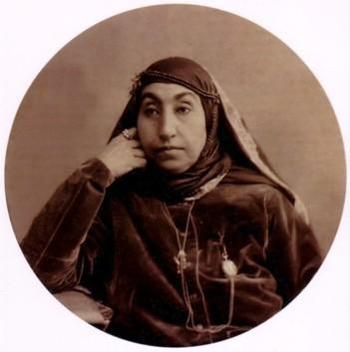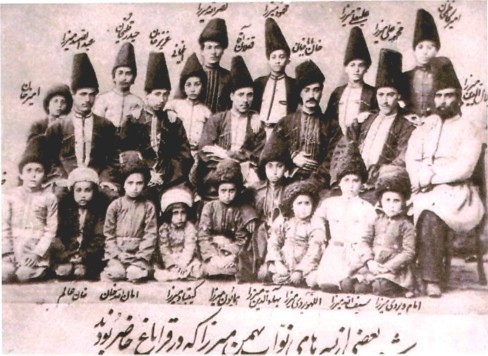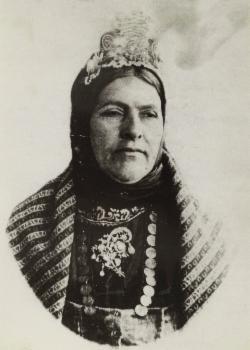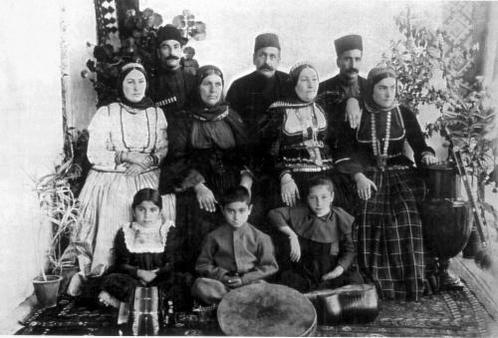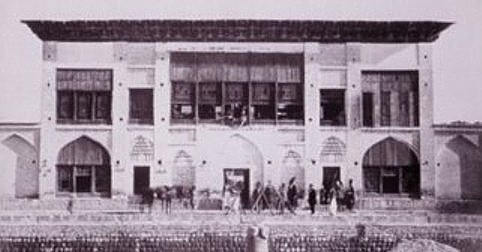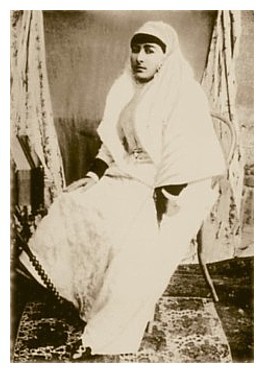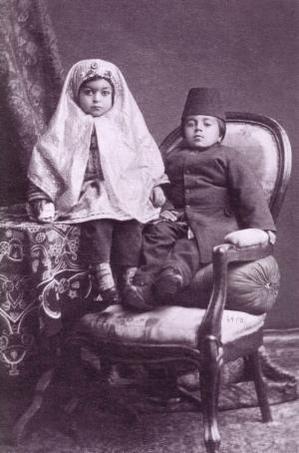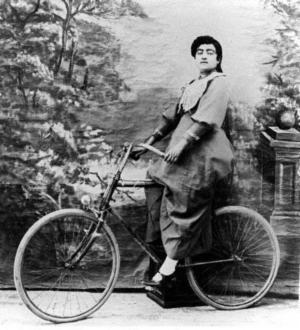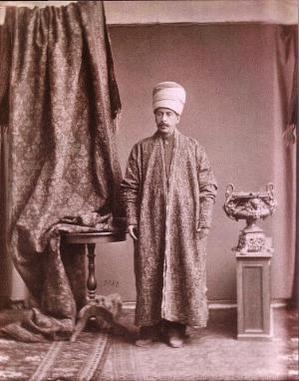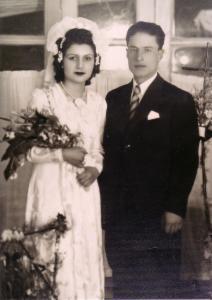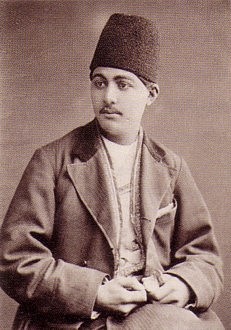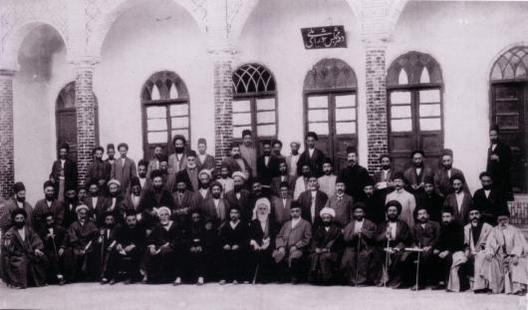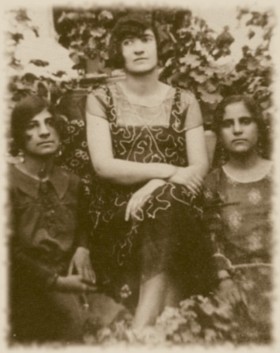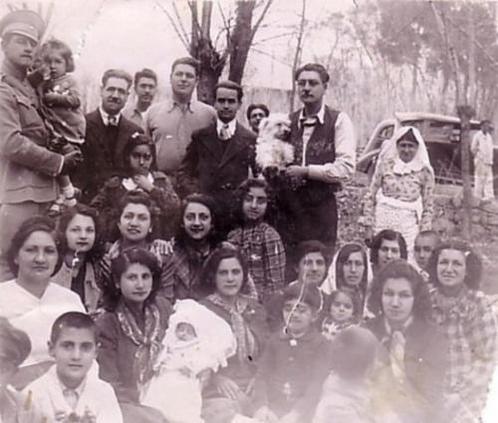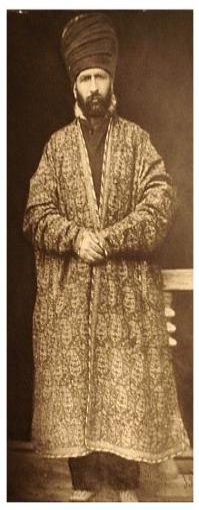Prince Bahman Mirza's family were our Bahman-Qajar ancestors....
The House of Bahman - Dignitaries and Diplomats
The House of Bahman is the second main ancestry branch of our family, tracing back to the
Qajar Dynasty of Persia and here to the
Bahmani Line, especially. Over several generations the Bahmans were dignitaries at royal court and diplomats for the Iranian government. Eponym of this branch is our famous forefather Nawwab-e Wala (lit. "His Excellent Highness") Prince Bahman Mirza Qajar, Viceroy of Azerbaijan and Governor-General of Tabriz. Thus, the House of Bahman is very closely related to the
Qajars (Kadjars) of Azerbaijan and his family is very popular in Russian Azerbaijan which forms today the Independent Republic of Azerbaijan (to see an article from WIKIPEDIA in Russian about Bahman Mirza -
click here).
Prince Bahman Mirza Qajar (1810-1884)
- Unique Pearl of the Imperial Sea -
Prince Bahman Mirza Qajar.
Prince Bahman Mirza Qajar was the 4th son of Fath Ali Shah's crown prince Abbas Mirza "Nayeb os-Saltaneh" by the latter's first and chief wife Princess Assiyeh (Jahan) Khanom Davalu (the daughter
of Amir Mirza Mohammad Khan Qajar-Davalu and sister of Hajji Allayar Khan "Asaf od-Dowleh", ruler of Khorassan and sometimes prime
minister to Fath Ali Shah). Therefore he was the next younger full brother to Mohammad Shah Qajar. He was born on 11th of October 1810 in Golestan Palace at Tehran and died on 11th of February 1884 in exile in Shusha, in the
Russian-occupied Qarabagh region. Bahman Mirza was educated privately at Tabriz with some of his brothers by the famous Qa'em Maqqam viziers father and son, Mirza Issa Farahani (Mirza Bozorg)
and Mirza Abol Qassem "Qa'em Maqqam".
As one of the very well educated and most learned among the numerous
Qajar princes, Bahman became a man of letters and a patron of literature and fine arts, very interested in geography, European history and modern natural history. Always amiable and generous in his dealings with others, he gave scholars, poets and artists a special place of honour. Therefore, authors and translators dedicated many works to him. Among these works were the famous stories of Thousand and One Nights or Arabian Nights (Arab. alf leyla wa leyla), translated into Persian by the popular Iranian poets Abdol Latif Tassuji Tabrizi and Mirza Sorush on demand of Bahman Mirza. This masterpiece of manuscript (Pers. hezar-o yek shab) was at least finished by the illuminations of Abol Hassan Ghaffari "Sani ol-Molk" under the patronage of Dust Ali Khan "Moayyer ol-Mamalek" in the time of Nasser od-Din Shah. Bahman Mirza was an able politician and good governor as well as a collector of art. An avid reader and bibliophile he possessed a magnificent library, he collected a compilation of Persia's best poets and named it after his brother the shah Tazker-e Mohammadshahi, and honorably was named with the epiphet Yegan-e Gowhar-e Darya-ye Khosravi (lit. "Unique Pearl of the Imperial Sea").
For an article about Bahman Mirza in Encyclopaedia Iranica -
click here.
The young Bahman Mirza at Fath Ali Shah's court, portrayed 1828 by Mohammad Hassan: "Hazrat-e Aghdas-e Shahzadeh Bahman Mirza Qajar farzand-e Vala Hazrat-e Homayoun Vali Ahd Shahzadeh Abbas Mirza Qajar Nayeb os-Saltaneh".
There is nothing further known about Bahman Mirza's childhood and youth at the courts of Tehran and Tabriz, but his political career started in 1828 and he was appointed 1831-1834 governor of Ardabil by Fath Ali Shah. Soon after the latter's death in August 1834, Bahman Mirza and other sons of Abbas Mirza were arrested and imprisoned in the Ardabil citadel, the traditional place for political captives of the imperial family, in order to avoid a revolt against the new monarch, Mohammad Shah. But shortly thereafter Bahman Mirza was led free by pressure of his mother to the shah. After that Bahman Mirza aided Mohammad Shah to enter Tehran and was appointed governor of Tehran on 21rst of December 1834 and commander-in-chief of Tehran, too. Then, from 1834 to 1841, he was governor (
hakem) of Borujord, Silakhor and Hamadan and finally he became fieldmarshal (sepah-salar). After the death of his brother
Qahreman Mirza (the founder of the Qahremani-Qajar family) in 1839 Bahman Mirza succeeded him as governor-general of Azerbaijan in January 1841 on behalf of his mother, who obviously showed her favour for nobody else than her own son. This made Bahman Mirza ruler over Persia's riches province and one of the most powerful princes of the imperial family. He was chosen not only because of his status within the imperial family as the shah's last full brother and highest ranking prince of Abbas Mirza's house, supported by the queen mother and her Davalu brothers, but also because he was an able governor. Under his rule Tabriz became an open cosmopolitan city, again with a large cultural circle. Also he wanted to modernize the army and to change the systems of tax and justice. Under his tolerant governorship, the religious sect leader Seyyed Ali Mohammad, called the
Bab, could take residence in Tabriz before Mohammad Shah demanded Bahman Mirza to arrest and escort the Bab to jail. Further more Bahman Mirza attacked the practice of asylum (bast) in order to bring the clerical forces under closer control. He also tried to modernize Persia's sanitary system and tried to ban a further new outbreak of Asiatic cholera by ordering the end to the traditional practice of temporary burials of dead bodies before transport to holy ground, which was a reason for recurrent outbreak of cholera in Persia.
In possession of the most important Qajar post, traditionally held by the Prince Royal, finally the two European powers, Russia and England forced the Persian government to confirm Bahman Mirza as viceroy for his ill-fated brother Mohammad Shah and the minor crown prince Nasser od-Din. When the shah's maternal uncle Hajji Allayar Khan "Asaf od-Dowleh" at least wanted to depose the weak Mohammad Shah in favour for his brother Bahman Mirza and marched with his troops led by his sons against Tehran, the prime minister Hajji Mirza Aghassi (Molla Abbas Erevani) got wind of this conspiracy and he prepared the shah to believe that his brother was a conspirator ready to snatch the throne. While the Davalu troops were defeated by the royal army, Asaf od-Dowleh escaped to Ottoman Iraq. The queen mother was on the pilgrimage of the Hajj to Mecca and Bahman therefore lost his two main royal supporters. Thus, by a tactical manoevre by Aghassi Prince Bahman Mirza was made believe that Khosrow Khan Gorgi, a crucial eunuch in the shah's service, was on his way to arrest the Prince while subduing the opponent Kurdish governor Reza Qoli Khan Ardalan. So, not to fall in Khosrow Khan's hands by order of Hajji Mirza Aghassi Bahman Mirza was forced to eject from his seat of power in Azerbaijan and resigned his successful and popular government under pressure in 1847. Bahman fled to the capital of Tehran, where he hoped to find among the foreign representatives an open ear. The European powers indeed demanded that Bahman be reinstated, but Aghassi resisted. Instead he ordered that Bahman's six large estates had been confiscated and made crown domains in November 1847. A move that finally on 1rst of March 1848, fearing for his safety and life forced Bahman Mirza to take refuge in the house of the Russian envoy in Tehran, where he was subsequently granted asylum. On 15th of May Bahman Mirza left Tehran accompanied by his wives, children, secretaries and servants and took up residence at Tiflis, the capital of the Russian dominated Georgia. In 1853 Bahman Mirza moved from Tiflis to Shusha in the Russian-occupied Karabagh region, protected as a prince of the Russian Empire on a hefty pension of the tsar of 30,000 silver rubles (15,000 tuman) yearly. He was still Russia's nominate candidate for the throne of Persia and each year gave him another princely sum under another heading.
When the young Nasser od-Din Shah ascended the Qajar throne after Mohammad Shah's death in 1848, new struggles about the return, position and reinstallation in office of Bahman Mirza rose up again. But the question about protection and succession to Nasser od-Din Shah remained academic, when the shah ruled powerfully, survived until 1896 and no regent was appointed. Finally, the shah nominated Mozaffar od-Din Mirza (the later Mozaffar od-Din Shah) for crown prince in 1862 and all claims of Prince Bahman Mirza came to an end.
Bahman Mirza at the age of 37 in full royal regalia with marshall's baton, sash and orders.
On 26th of May 1873 Bahman Mirza's third son,
Prince Reza Qoli Mirza, once Nasser od-Din's favourite cousin, who served then with his sons and some brothers in Tsarist military and court, requested an audience with the shah during the shah's journey to Europe and his visit at Russia's capital St. Petersburg. Reza Qoli Mirza was the speaker for his entire family, asked Nasser od-Din Shah for pardon and accepted him officially as their sovereign and head of their dynasty sending regards and devotion from his father. Nasser od-Din Shah himself agreed that intrigues of the former premiers and an error in his own father's politics had forced his uncle for exile. The shah forgave Bahman Mirza his attitude and accepted Bahman's offspring as princes at his royal court at Tehran and among his officials, Bahman Mirza's family should belong again as one of the first princely lines in his imperial family. After that Bahman Mirza made claims for returning his confiscated possessions in Persia to Nasser od-Din Shah and even asked the German Reichskanzler Prince Bismarck for mediation. Thus, on the occasion of the International World Exhibition in Vienna and the gathering of all heads of states he addressed a petition to the German crown prince Frederick of Prussia (the future Emperor Frederick III) but at last did not receive his full possessions and finally refused his own return to Persia and died in Russian exile.
This letter in Bahman Mirza's own words written in Russian and translated into German still does exist in the German Foreign Ministry's Archive:
"Allergnädigste Monarchen,
Herrscher der großen Staaten Europas!
Indem ich die angemessene Gelegenheit der Zusammenkunft der Hohen Monarchen auf der Weltausstellung in Wien benutze, betrachte ich es als Glück für mich, meinen gegenwärtigen Zustand Ihren Majestäten zur geneigten Betrachtung zu unterbreiten.
Vor 26 Jahren, als ich in Tauris Regent der Provinz Aserbedschan war, hat mein leiblicher Bruder, Mamed Schach, auf Verläumdung des damals in Persien regierenden Veziers Hadshi-Mirsa-Agassi, mich nach Teheran berufen.
_Wenngleich ich nun auch in folge dessen unverzüglich dort eintraf, so konnte ich, trotz aller meiner Bemühungen, durch die Intrieguen dieses hinterlistigen Veziers, mich nicht Seiner Majestät behufs persönlicher Erklärung vorstellen._
Nachdem ich hierauf sah, daß schon entschiedene Maßregeln getroffen waren, mich ins Verderben zu stürzen, flüchtete ich zu dem Bevollmächtigten Russischen Minister, bei welchem ich auch mein Leben rettete. _Hierbei sind meine Kostbarkeiten und andere Mobilien geraubt worden; und nachdem ich mit meiner Familie in Rußland angekommen war, wurden die mir eigentümlich gehörigen, durch Kauf erworbenen sechs Güter konfisziert, welche meine jährliche Revenue von ca. Zwanzig Tausend Rubel nach russischem Geld ergeben._ Wenngleich ich nun auch wiederholt and die Persischen Veziere, unter Absendung von bedeutenden Geschenken an dieselben, geschrieben und um ihre Verwendung bei dem Schach, wegen Rückgabe dieser Güter an mich, gebeten habe, so ist meine Bitte doch ohne Erfolg geblieben._
Es ist nicht gewissenhaft, daß der König von ganz Persien, mir, seinem hochbejahrtem Oheim mit seiner großen Familie, meine eigenen Güter konfisziert hat, um so mehr, als gerechter Weise mir von der Persischen Regierung ein Unterhalt gewährt werden müßte._
Daß ich der Heimath und meines Vermögens vollständig schuldlos, nur durch die Intrieguen und den verschmitzten Charakter des Veziers Hadshi-Mirsa-Agassi verlustigt gegangen bin, ist allen in Persien existierenden Gesandtschaften und Botschaftern der Hohen Mächte bekannt._
Unschuldig beleidigt, rufe ich die Gerechtigkeit der Mächtigsten Fürsten in der vollen Hoffnung an, daß Ihre Majestäten, in Berücksichtigung meiner Lage gerufen werden, meinen Neffen Nasradin Schach aufzufordern, mir, in Form einer Gnade, meine sechs Güter zurück zu geben, deren Revenuen als Hilfsmittel zu meiner und meiner großen Familie Unterhalt in der Fremde dienen könnten.
Wenn mein begründetes Gesuch, wider meiner Erwartung, keiner Beachtung gewürdigt werden sollte, so wird meine Seele wenigstens von der auf derselben lastenden Macht der Willkür Erleichterung finden, das mir zugefügte schreiende Unrecht zur Kenntniß der Hohen Monarchen zu bringen._
Gegenwärtiges Gesuch wird allerdemütigst sechs Hohen Monarchen, Jedem einzeln unterbreitet._
May im Jahre 1873.____
Gez. Bahman Mirza, Sohn des Regenten Abbas Mirza.“
Bahman Mirza's handwritten signature and seal: He signed with Bahman Mirza ebn-e Nayeb os-Saltaneh Abbas Mirza ("Bahman Mirza son of the Deputy of the Monarchy Abbas Mirza") and sealed Yegan-e Gowhar-e Dariya-ye Khosravi Bahman (lit. "Unique Pearl of the Imperial Sea, Bahman").
During his lifetime Prince Bahman Mirza Qajar married 16 wives, most of them from the local nobility and Qajar aristocracy of Azerbaijan. Among his spouses are known by their name:
1. Malek-Soltan Khanom (daughter of Prince Mohammad Taghi Mirza "Hessam os-Saltaneh", Fath Ali Shah's 7th son)
2. Shahzadeh Khanom
3. Malek-Jahan Khanom (daughter of Mohammed Qoli Khan Qajar-Quvanlu)
4. Mehr Farid (Mirvarid) Khanom (daughter of Mehdi Qoli Khan of Talesh)
5. Kuchek Barda Khanom (daughter of Qurban Beyg Ghazi)
6. Govad Khanom (a Kurdish from Tabriz)
7. Gowhar Khanom (daughter of Ismail Khan of Nakhshivan)
8. Chichek Khanom (a Kurdish from Tabriz)
9. Gorji Khanom (a lady from Georgia)
10. Aferin Khanom Agha-Abdollah (a lady from Shusha and sister of Farkhonda Begum, wife of Prince Shahrokh Mirza), his last wife.
He left a large number of offspring and his children were 33 sons and 30 daughters. Most of them continued to stay in Azerbaijan, serving in Tsarist government and military and founded the Azerbaijani families of Kadjar, Ghajar, Bahmanov and Persidskii.
Persian Postcard of Prince Bahman Mirza from Azerbaidjan in 1910, and oil painting by John Casolani in 1846, both depicting our forefather as powerful regent and vicegerent of Tabriz.
Portrait of Prince Bahman Mirza Qajar in detail and with his two sons, Prince Mohammad Ali Mirza (left) and Prince Qoflan Agha (right), Shusha/Karabagh 1862.
Princess Malek Soltan Khanom Qajar, one of Bahman Mirza's senior chief wives.
Some of Prince Bahman Mirza's sons presented in Karabagh, 1869 (Persian depiction: "Shebeh b'azi az pesarha-ye Nawab-e Bahman Mirza ke dar Qarabagh hazer budand"). First row (kneeling from left to right): Khan Jahan Mirza, Khan Alam Mirza, Amanollah Khan, Keyqobad Mirza, Homayun Mirza, Baha od-Din Mirza, Allahwerdi Mirza, Seyfollah Mirza, Emamwerdi Mirza. Second row (sitting): Abdol Samed Mirza, Aziz Khan, Qoflan Agha, Khan Baba Khan, Mohammad Ali Mirza, Jalal od-Din Mirza. Third row (standing): Amir Khan Mirza, Heydar Qoli Mirza, Ilkhani Mirza, Nasrollah Mirza, Mahmud Mirza, Ali Qoli Mirza, Amir Kazem Khan.
Barda "Kuchak" Khanom, one of Bahman Mirza's junior wives.
Barda Khanom with some of her children: Prince Ardashir Mirza, Khan Jahan Mirza, Keyqobad Mirza, Princesse Firouzeh Khanom, Bekhjad Khanom and Ashraf Khanom.
Prince Anushiravan Mirza Bahman "Zia od-Dowleh" (1833-1899)
Prince Anushiravan Mirza "Zia od-Dowleh".
Prince Anushiravan Mirza "Zia od-Dowleh" was the first born son to Prince Bahman Mirza by Malek Soltan Khanom. Born in 1833 when his father was governor of Ardabil, he was named after the famous
Sassanian King Khusrow I (r. 531-579), who was called Anushiravan or "Immortal Soul". 1848 he followed his father to exile but
returned to Iran and lived in Tabriz. After his younger brother Reza Qoli Mirza had arranged with Nasser od-Din Shah Anushiravan Mirza was installed in power: 1873 Anushiravan Mirza was appointed
city governor (hakem) of Turshiz and then made provincial governor (beyglarbeygi) of the district of Borujord and the province of Lorestan. 1881-1882 he was given the post of governor of the city of
Tabriz and the district of Damghan, 1884-1886 he was governor of the province of Semnan, of Damghan and Shahrud. 1888-1889 he was governor of Lorestan and Borujord a second time, in 1891 he had the
vizierate of the province of Kermanshah on behalf of Governor Hassan Ali Khan Garrousi "Amir Nezam", and 1898-1899 he was again governor of Semnan and Damghan. Beeing the shah's next first cousin, he
also got the title of "Zia od-Dowleh" (lit. "Splendour of the State"), which he inherited from his uncle Prince Mohammad Rahim Mirza "Zia od-Dowleh" (Abbas Mirza's 19th son) and finally was assigned
with the military rank of Amir-e Tuman (lit. "Commander of 10,000", i.e. Major-General). H.H. Prince Anushiravan Mirza "Zia od-Dowleh" "Amir-e Tuman" died on 23rd of October 1899 in Shusha.
Anushiravan Mirza married firstly as his main wife Badie ol-Jamal Khanom I, daughter of Mohammad Hassan Khan "Sardar" Iravani by Princess Mahrokhsar Khanom "Fakhr od-Dowleh", daughter of Abbas
Mirza and sister to Mohammad Shah and Bahman Mirza. Secondly he married a daughter of his maternal uncle Prince Amir Teymur Mirza. He had issued several children, among them his sons Prince Soltan
Ahmad Mirza and Prince Soltan Majid Mirza, and the Princesses Malekzadeh Khanom and Malekeh-Afagh Khanom Bahman.
Thomas Stevens 1887 told in his travel-diary Around the World on a Bicycle:
"Prince Anushirvan Mirza, Governor of Semnoon [Semnan], Damghan, and Shahrood, is the Shah's cousin, son of Baahman Mirza, uncle of the Shah, and formerly Governor of Tabreez. Baahman Mirza was discovered intriguing with the Russians, and, fearing the vengeance of the Shah, fled from the country; seeking an asylum among the Russians, he is now--if not dead--a refugee somewhere in the Caucasus. But the father's disgrace did not prejudice the Shah against his sons, and Prince Anushirvan and his sons are honored and trusted by the Shah as men capable of distinguishing between the friends and enemies of their country, and of conducting themselves accordingly.
The Governor's palace is not far from the north gate of the city, and after the customary round of tea and kalians, without which nothing can be done in Persia, he walks outside with his staff to a piece of good road in order to see me ride to the best advantage. (As a specimen of Persian extravagance--to use a very mild term--it may be as well to mention here as anywhere, that the Governor telegraphed to his son, acting as his deputy at Shahrood, that he had ridden some miles with me out of the city!)
During the evening one of the Governor's sons, Prince Sultan Madjid Mirza, comes in with a few leading dignitaries to spend an hour in chatting and smoking. This young prince proves one of the most intelligent Persians I have met in the country; besides being very well informed for a provincial Persian, he is bright and quick-witted..."
M. Bamdad incorrectly counted Anushiravan Mirza among the sons of his uncle Mohammad Rahim Mirza and said about him: "Anushiravan Mirza Zia od-Dowleh, the child of Mohammad Rahim Mirza Zia od-Dowleh, 19th son of Abbas Mirza Nayeb os-Saltaneh was made in the year 1884 governor of Semnan, Damghan, Shahrud and Bastam; and in the year 1888 when the situation of Soltan Massud Mirza Zell os-Soltan's governorship became confused, Lorestan and Borujord were seperated and were entrusted to his care. Zia od-Dowleh was appointed to the post of governor of these mentioned provinces and sent there. But his governorship did not last more than one year when he was withdrawn from office and in the year 1889 recalled to the centre. And instead of him Agha Reza Khan Nazem Khalvat, a relative to Amin os-Soltan, who could nor read neither write was installed in power."*
The governor's residence and Bahman Mirza's palace "Bagh-e Shomal" in Tabriz.
Prince Anushiravan Mirza Qajar "Zia od-Dowleh" mit two men of the royal guard.
------------------------------------------------------------------------------------------------------------------------------------ * Anushiravan Mirza Zia od-Dowleh farzand-e Mohammad Rahim Mirza Zia od-Dowleh pesar-e nouzdahom-e Abbas Mirza Nayeb os-Saltaneh dar sal-e 1301 h.q. hakem-e Semnan, Damghan, Shahrud va Bastam va dar sal-e 1305 h.q. ke oza'-e hokumat-e Soltan Massud Mirza Zell os-Soltan beham khord va Lorestan va Borujord az abvabjami'-e u montaze' gardid. Zia od-Dowleh besemat-e hokumat-e valayat-e mazbureh mansub va ferestadeh shod lakan hokumatash bish az yek sal tul nakeshid ke az hokumat ma'zul va dar sal-e 1306 h.q. be markaz ehzar shod va bajayash Agha Reza Khan Nazem-Khalvat az mansuban-e Amin os-Soltan, ke savad-e khandan va neveshtan ra niz nadashteh ast, talin gardid.
Princess Malekeh-Afagh Khanom Bahmani-Qajar (1864-1917)
H.H. Princess Malekeh-Afagh Khanom Bahmani-Qajar. This
photograph was made by Antoin Sevruguin in Tehran 1900.
Our own family's fate depended as well on the negotiations of Prince Reza Qoli Mirza with Nasser od-Din Shah and the position at court of Prince Anushiravan Mirza "Zia od-Dowleh" after his
decision to return back to Iran.
Princess Malekeh-Afagh Khanom (lit. "Queen of the Universe") was born in 1864, died on the Ashura day of 10th Muharram 1336, the 26 October 1917 at Tehran and was buried at the Holy Shrine of Shah Abd ol-Azim near Tehran. She was the granddaughter of Bahman Mirza and daughter of Anushiravan Mirza "Zia od-Dowleh" by Badie ol-Jamal Khanom I.
The family lived partly on their property of land and partly on an amount of Russian money, part of her grandfather's immense apanage from Russia. After the agreement of her uncle Reza Qoli Mirza
with their cousin Nasser od-Din Shah in 1873, the family again get access to the Qajar Imperial court and moved to the capital city of Tehran. Anyway, Malekeh-Afagh Khanom had a close connection to
all those of her uncles and cousins in Russian Azerbaidjan, who visit Persia frequently or moved back, especially after the Russian Revolution. This was the case with her uncle Jalal od-Din Mirza and
her cousins Kamran Mirza, Jamal Mirza, Darab Mirza and Qahreman Mirza, the sons of Prince Shahrokh Mirza. They settled down again in Iran in 1916 but most of them were blaimed for conspiration and killed by Reza Shah Pahlawi (r.1925-1942) in the late 1920's and
early 1930's.
Princess Malekeh-Afagh Khanom and her brother, the son of Prince Anushiravan Mirza "Zia od-Dowleh", as infants around 1870. This photograph was made by Dimitri Ermakov.
Princess Malekzadeh posing on a bicycle. The Bahmans were especially affected by bicycles first introduced in Iran at the end of the 19th century. Princess Malekzadeh Khanom had two daufghters:
Princess Monavvareh Khanom (Shazdeh Khanom) and Princess Monireh Khanom Bahman.
Prince Sahebqeran Mirza, Malekeh-Afaghs youngest uncle with a portrait of their ancestor Bahman Mirza.
Royal Decret of Designation of Sahebqeran Mirza as Chamberlain in Control by Crown Prince Mohammad Ali Mirza, 1903:
"The Crown Prince of the Realm - Thus, the levels of talent and propriety and ability of Sahebqeran Mirza, son of the late and God blessed Bahman Mirza, have attained [our] father’s benevolent attention and to pay him mercy and honour, we designed him according to this honourable decret as a member of the chamberlains in control, and paid him the honour to carry his supported duties and to operate in there. It is defined that Madjid ol-Molk “Amir Tuman”, the chief chamberlain and director of the Confidential Imperial Compilation provides him with his assistance in service by documenting...
Month of Rabi ol-Molud 1321 [May/June 1903]
Mohammad"
Malekeh-Afagh Khanom became the founder of the Bahman Family of the Qajar princely lines when her three sons and one daughter adopted in 1930 their grandfather's first name "Bahman" as their
common family name.
Princess Malekeh-Afagh was married two times. As her first husband she married in 1880 Mirza Hossein Behnam, the third son of Hajji Mirza Ali Akbar Mostowfi Tafreshi from the Behnam family, a widespread dynasty of bureaucrats originally from Tafresh. Asadollah Behnam wrote about his elder brother "Mirza Hossein Behnam ba Shahzadeh Khanom
Malekeh-Afagh keh az ouladha-ye Bahman Mirza Qajar budeh ast ezdevaj minemayad. Mirza Ali Akkbar bedin menasebt nam-e khanevadegi-ye madar-e khod Bahman ra ekhtiyar kardeh ast." And M. Pirouzan
continues: "M. Hossein le père de M. Bahman avait marié une princesse de la famille royale Ghadjar nommé Malakeh Afagh qui était l'une des enfants d'un prince Ghadjar qui s'appelais Bahman Mirza. M.
Bahman donc avait accepté le nome de sa famille maternelle tandis que les autres avait connué le nome de famille Behnam."
Mirza Hossein Behnam photographed by D. Ermakov.
By Mirza Hossein Princess Malekeh-Afagh Khanom had issued two sons: Mirza Ali Akbar and Mirza Ali Asghar Bahman.
H.E. Mirza Ali Akbar Khan Bahman, born 1883 at Tehran, had several diplomatic posts in the late Qajar era and under the rule of Reza Shah Pahlavi, and became sometimes
Minister for Trade. In 1907 Hajji Mirza Yahya Dowlatabadi, one of Iran's leading left-winged constitutionalists of the 1906 Revolution and founder of the modern school system, sent Ali Akbar to
Baku/Azerbaijan to teach at an Iranian school (Sa'adat). After World War I on 26 August 1919 Ali Akbar was appointed Envoy Extraordinary and Minister Plenipotentiary of Persia to Bucharest/Romania,
and then in 1921 became ambassador to Belgium. 1934 he was Iran's Imperial Ambassador in Afghanistan, and finally 1939-1943 in Egypt. In 1935 he firstly commissioned the "Arbitrary Arrangement"
between Iran and Afghanistan about some border region in Sistan, and later became Minister of Transport. He also was one of seven cabinet members who were responsible for the 1935 commemoration stamp
set. In Egypt, there he arranged the marriage of Mohammad Reza Pahlavi (in those days Crown Prince of Iran) with Princess Fowziyeh, daughter of King Fouad I and sister of
King Farouk of Egypt on 16th of March 1939. After
establishing his new dynasty, Reza Shah needed as well the support of the old elite as that he wanted the international aristocracy to accept the Pahlavis as new rulers over Iran. Therefore, he
firstly took Qajar ladies as his wives (Turan Amirsoleymani and Esmat Dowlatshahi) and then looked for an Islamic princess as a match for his oldest son Mohammad Reza, the heir apparent. The new
Pahlavi Rule of Succession prohibited a Qajar mother of the ruling line, thus a foreigner must have been chosen as new wife of the crown prince. So the eye fell on Princess Fowziyeh of Egypt, King
Farouk's sister and in those days "the most beautiful woman of Egypt". In that time the Royal House of Egypt belonged to the most "Westernized" and progressive dynasties in the Middle East with a
luxurious life standard. Reza Shah thought, that this marital bond with another ruling house would legitimate his new dynasty in the eyes of other countries, allowed access to the international high
society, and saved the Pahlavi monarchy in Iran. But finally after a daughter, Shahnaz was born, this marriage was unhappy and at last divorced in 1945 and Mohammad
Reza Pahlavi remarried.
Ali Akbar Bahman himself had married Zoleikha Khanom Gadjieve, a twenty year younger girl from an Iranian-Russian family from the Caucasus. She with her parents in 1919 fled from the Red Army and her
father was said to go to Iran and contact a certain Mr. Ali Akbar Bahman, who had good connections from his Baku years, family ties and will help them. They had one single daughter, Mehr-e Jahan
(Mehri) Khanom Bahman. But actually the diffenrence in age was too much, the alliance was not a love match and finally divorced when Zoleikha spent vacation in the spa of Wiesbaden, Germany. There,
Zoleikha remarried with a German Mr. Reinhardt and lived with her daughter in Winkel/Ruedesheim am Rhein, Germany. Thus, Mehri Bahman grew up in Germany, married firstly a German and after divortion
then in Tehran Mr. Mohammad Ali Pirouzan.
Back from his duties as ambassador in Egypt, where he also headed a gathering of Iranians at the embassy about Iranian Settlement in Egypt and participated in the Cairo Conference 1943, in Tehran Ali Akbar Bahman as a proud aristocratic possessed the Gowharshah House and a huge real estate in Vanak in Tehran's north at Bagh-e Mostowfi (lit. "Garden of Mostowfi"). He died 1967 at Tehran and was burried next to his mother at the beautyfully tiled
Bahman family mausoleum at the Shrine of Shah Abdol-Azim, Tehran.
Ali Akbar Bahman in formal court attire.
Ali Akbar Bahman with members of the foreign delegation.
Ali Akbar Bahman at the Conference of Cairo, 1943.
Ali Akbar Bahman with family members on a family wedding.
Ali Akbar Bahman, ambassador to Egypt, receiving Mohammad Reza Pahlawi and Princess Fowziyeh, Cairo 1939.
Banquett for the Iranian Crown Prince in Cairo in 1939, from right to left: The British Ambassador to Egypt, Lady Wilson, King Faruk of Egypt, Mohammad Reza Pahlawi with his Dinner Lady, far left H.E. Ali Akbar Bahman the Iranian Ambassador to Egypt.
Fowziyeh brought to Iran by her mother Queen Nazli (left). The Pincess' sister are attending as well as Mohammad Reza Pahlawi (right) and Ali Akbar Bahman (in the background).
Ali Akbar Bahman with his young wive and his baby daughter, around 1920.
Mehri Bahman with her mother Zoleikha.
Mehri Bahman as bride.
Mehri Bahman and M. A. Timsa Pirouzan.
Mirza Ali Asghar Bahman,
born ca. 1882, was a high civil servant at the Ministry for Post,
Telephone and Telegraph during the reign of Reza Shah Pahlavi. He
married his two maternal second cousins Ezzat
os-Saltaneh Khanom and Nezhat od-Dowleh Khanom, daughters of his
mother's niece Princess Monawwareh Khanom Bahmani-Qajar (named Shazdeh Khanom),
and had issued by them two daughters and one son: Taliyeh-Afagh Khanom
Bahman, Badiyeh ol-Jamal Khanom Bahman and Cyrus Bahman.
Badiyeh ol-Jamal Khanom Bahman at her wedding with Ahmad Zarrinnaal, in the 1930's
.
Four Bahman ladies: Badiyeh ol-Jamal Khanom, Taliyeh-Afagh Khanom, Mehri and Pouran, Cyrus Bahman's wife, in 1950's.
Secondly Princess Malekeh-Afagh Khanom married after Mirza Hossein's death in 1896, at Tehran her maternal relative, Amanollah Khan Donboli Tabriz "Nazer ol-Ayalat" "Zia os-Soltan", son of Mohammad Zaman Khan Donboli (Safar Khan) from the family of the Khans of Tabriz, a Qajar dignitary at the crown princes divan
of Tabriz. It is said that the wedding celebration of Malekeh-Afagh Khanom to Amanollah Khan "Zia os-Soltan", was one of the most beautiful weddings in all of Iran.
By Mirza Amanollah Khan "Zia os-Soltan" she had issued one daughter and one son, Nosrat ol-Molouk Khanom Bahman and
Abol Qassem Safarkhanlu Bahman.
Amanollah Khan Donboli "Zia os-Soltan" (1860-1931)
Amanollah Khan "Zia os-Soltan", 1912.
Amanollah Khan Donboli, sometimes called Tabrizi (meaning "Descending from Tabriz") and honorary entitled "Zia os-Soltan" (lit. "Splendour of the Sovereign") for his merits in affairs of state by Mozaffar od-Din Shah, was born at Tabriz in 1860, died on 11th of February 1931 by cancer at Hamburg/Germany on a visit to medical specialists and was buried there at the Iranian-Muslim department of Ohlsdorf Cemetary Hamburg. His father was Mohammad Zaman Khan son of Hajj Qolam Ali Khan Donboli "Amin-e Divan", sometimes governor of Khoy and Tabriz. His sister was Fatemeh Khanom who married Mohammad Hossein Vafa'i, issued four sons Abbas, Esmail, Eskandar and Mikhail, and became the mother of the Vafa'i family.
The Donboli family ruled as hereditary Khans various parts of the province of Azerbaijan including the cities of Khoy and Salmas since the Aq Quyunlu and Safavid time. After Nader Shah Afshar one line of the clan allied with the early Qajars and became governors of Tabriz. In 1809 the crown prince Abbas Mirza became vicegerent of Azerbaijan and governor-general of Tabriz and the khanate was abolished. But the family still hold large land properties and various governmental post. So, Amanollah Khan was a very wealthy big landowner with huge estates at Tabriz and the village of Alamdar.
In Mozaffar od-Din Mirza' time as crown prince, Amanollah Khan entered his court at Tabriz and became one of the crown prince's companions entrusted with the office of "Nazer al-Ayalat" (lit. "Warden of the Province"), while his uncles held the posts of "Beglerbegi" and the "Eftekhar ol-Molk". When in 1897 the new shah Mozaffar od-Din Shah (r. 1896-1906) took residence at Tehran, Amanollah Khan followed the imperial entourage to the capital with the so-called "Turk" fraction and was awarded with the title of "Zia os-Soltan" by the shah. There, at Teheran he married in 1897 H.H. Princess Malekeh-Afagh Khanom Bahmani-Qajar, by whom he got his two children. After her death in 1917 he married secondly a rich landlady from Damghan, Turkan Aqa Khanom but without any issue. With his marriage to a Qajar princess Zia os-Soltan then was close related to the Imperial Family. They lived in the newly illuminated district of Tcheragh Bargh (lit. "electric light"), which then was called Khiyaban-e Bargh. As a liberal Qajar aristocratic, a man who stood up for the politics and democracy, called Tabrizi he was delegate of Tabriz at the first Persian National Council to Tehran, when on 15th of August 1906 Mozaffar od-Din Shah proclaimed after the Constitutional Revolution reforms and a parliament. There, he became on 7th of October 1906 member of the new founded
parliament (majles) and a leader of the constitutional wing (
ejtema'
iyun) ready for democratic reforms. He was also one of those Qajars notables, who supported the constitution against efforts of Mohammad Ali Shah (r. 1906-1909), for return to absolutism in 1908. When Mohammad Ali Shah acceded to the throne in 1906, he feared that the European powers, especially Britain, could strengthen their influence via the parliament. However, the shah rejected his father's democratic measures and, dissolving the First Majles, reclaimed absolute power. Finally, riots broke out in Tehran and Tabriz against the government and constitutional forces rose up in both cities. On 4th of June 1909 Mohammad Ali Shah, fearing for his personal safety, left Golestan Palace for Bagh-e Shah (lit. "Royal Garden"), a residence just outside the city and later a village for the aristocracy, where he would be safe under the protection of the Cossack Brigade. When the people protested against his politics, the shah demanded the Cossacks for bombarding the parliament building Baharestan (lit. "Place of Springtime"). Then, a few days later, Zia os-Soltan was arrested with some other political leaders and Qajar princes, too. He was accused of being involved in a bomb assault against the shah. The only food for each prisoner a day was one round bread and cucumbers. They were denied fresh cold water and thus they were forced to drink the dirty water of a small pool. Each day their guard, a certain Soltan Bagher, would take them out eight by eight in chains, and brought them to the tribunal of interrogators. These men supporting the shah’s autocratic style to rule were Moayyed od-Dowleh (the Governor of Tehran), Prince Moayyed os-Saltaneh, Seyyed Mohsen Sadr ol-Ashraf, Mir Panj Arshad od-Dowleh, Mirza Abdol Motalleb Yazdi (the editor of the royalist Adamiyat newspaper) and Mirza Ahmad Khan (the writer of the police station). The tribunal was investigating three matters and by means of torture and pressure wanted to get information about: 1) Who had thrown the bomb at the Shah? 2) Who was the founder of the
anjoman (freemason's lodge) the house of Ali Reza Khan Qajar Amirsoleimani “Azod ol-Molk” (a Qajar elder and the tribal head or Ilkhan, who became later regent to the young Ahmad Shah, who was suspected in plotting against Mohammad Ali Shah and replacing him with his uncle Soltan Massud Mirza “Zell os-Soltan”)? 3) Who was giving rifles to the mojaheds? Other than that they were not interested in the events of the Majles and the Mashruteh.
In all this they would not spare the prisoners any torture or hurt with regard to some of them in particular, especially the editor of the Rouh ol-Qodos newspaper, Soltan ol-Olama Khorasani “Rouh ol-Qodos”, and Zia os-Soltan. Because these two men were suspected that they had knowledge of the background to the attempt on the shah’s life, they were subjected to severe torture. Every night they would be taken out and tied to stools and beaten severely and though their cries would resonate in the entire Bagh-e Shah, none of those Generals and Ministers present would come to their rescue.
Finally before his execution Zia os-Soltan was then released with others accused of being guilty of the attempt on Mohammad Ali Shah’s life, among them Heydar Amoghli, Esmail Ghafghazi, Mirza Mousa Khan Zargar and Reza Azarbeidjani, who had thrown the bomb. This happened when revolutionary troops, backed by the British, moved into Tehran in July 1909, took over the city and could free Zia os-Soltan and the others. Three days later, Mohammad Ali Shah asked for asylum in the Russian embassy, was forced to abdicate and leave the country. In his place his twelve-year-old son, Soltan Ahmad Shah (r. 1909-1925), was made ruler under the supervision of a regent. Thus, in the next decade Amanollah Khan "Zia os-Soltan" was political advisor of the young shah's government.
Young Amanollah Khan in 1878.
Deputies of the First Majles: First row sitting second and third at the right side my two great-grandfathers, Amanollah Khan "Zia os-Soltan" and Ali Akbar Khan "Nasr-e Lashkar".
The Coronation of Soltan Ahmad
Shah
My great-grandfather
Zia os-Soltan, also veteran and hero of the Constitutional Revolution, as
representative of his wing in parliament, took part at the
coronation of Soltan Ahmad Shah Qajar, Iran’s young constitutional monarch: "In summer of 1332 (1914) just before the Great
War’s outbreak, it was time for coming of age of the seventeen-year old Ahmad
Shah (who had been already declared ruler under regency five years before when
his father Mohammad Ali Shah was deposed), the retirement of the Regent Nasser
ol-Molk and the presumption of the Shah’s full power. The young Shah was crowned on his eighteenth
birthday, the 28 Sha’ban (21 July) of that same year in the splendid throne-hall
of the Golestan
Palace. The audience counted not more
than 150 persons including members of the Imperial family, Qajar aristocracy,
chiefs of the main tribes, the Cabinet Ministers, whom the most important attending
that occasion were Ala os-Saltaneh (Prime Minister), Vossough od-Dowleh
(Foreign Affairs), Qavvam os-Saltaneh (Finance), Hakim ol-Molk (Public
Affairs), Mostowfi ol-Mamalek (War) and Arfa od-Dowleh (Justice), the
diplomatic corps of Tehran, a few clerics, some generals and important foreign
advisers. It was the first coronation of an Iranian
monarch in public. Until the Qajars neither a coronation nor even a crown was
in use by Persian dynasties since the advent of Islam; and due to traditional
customs of the Qajar court previous coronations only took part in the limited
circles of the Imperial family and Qajar tribe. Thus, the coronation was a
plain and simple ceremony, and comparing to the opulence of later coronations under
the Pahlawis, the ceremony lacked pomp and majesty. But because of Iran’s
increasing international relations to foreign powers and prestige it became an
official court matter. When all the persons present had taken their places,
the Shah appeared in a black frock coat with golden epaulettes and golden
buttons, gloved in white glacés, and wearing the state regalia: the Imperial
light-blue sash, the order of the Lion-and-Sun highest class, the enormous
jewel-studded Imperial sword, and a black astrakhan hat decorated with the
famous big pink diamond in front called Dariya-ye Noor or “Ocean of
Light”, topped by an aigrette with white heron plumes. After acknowledging the
greetings of the audience, he who bowed, went straight to the legendary peacock
throne and sat down, surrounded by standing courtiers. The military band outside
in the court yard played the National Anthem "Salamati-ye Shah" once composed by Jean Baptiste Lemaire for Nasser od-Din Shah. Then
the two highest clerics, the
Imam-e Jom’e of Tehran and the Sheikh
ol-Eslam, approached, one from each side, and a court official from the
Tajbakhsh family of the Qajar-Davalu tribe (traditionally this branch of the
Qajars has had the right to crown the shah since Agha Mohammad Khan) tendered
to them the Imperial crown on a velvet cushion. The Qajar Imperial crown or Kayanid crown was rather high and heavy, entirely covered with priceless pearls and precious
stones, a huge emerald at its final and surmounted by a large diamond aigrette.
The two priests took the crown together and put it on the Shah’s head after he
had removed his black astrakhan hat, and had handed to a court dignitary. The
crown was really heavy, and when the priests removed their hands it nearly fell
off, the Shah being obliged to seize it and to hold it for a while until
protocol allowed him to remove the crown and give it back to the courtier. After that the Shah again put on his black hat
and listened to speeches and poems recited by the Poet Laureate, the cannon at
the Cannon Square or
Meidan-e Toupkhaneh
firing 101 shots of salute. The whole ceremony lasted about forty minutes,
after which the new sovereign came down from his throne and disappeared through
a small door, while the military band again played the National Anthem. The following oath-taking ceremony was
performed at the National Assembly or Majles in the Baharistan Building
where parliament took place. All deputies wore their best robes, pleated
frock-coats or official garbs, and there was one loge for high dignitaries, one
for the important army commanders, one for foreign attachés, and one for the
press. The Shah arrived in the black and golden state carriage, drawn by four
beautiful horses from the Imperial stables. He was followed by troops of mounted
Cossacks dressed in their Caucasian-style
cherkesskas or Cossack tunics,
Gendarmes in fancy uniforms and by traditional footmen or farrashes. The
common people crowded on the Baharistan Square
in front of the Parliament Building and greeted the
sovereign by clapping the hands in jubilation. When the Shah climbed up the
rostrum, all present rose from their seats, the guns began to fire and the monarch
read the oath formula, swearing on the Koran to respect the Constitution and to
work for his people. Finally the official photograph was made by the court
photographer. Then the Shah departed and the ceremony was finished. After that for
the immediate Imperial entourage there was a thanksgiving service in the Sepah
Salar Mosque. Also at night there was a reception of state
guests according to European court etiquette in the Saltanabad Summer Palace in
Tehran’s north with a formidable dinner. Now that Qajar palace did not exist
anymore, destroyed by Reza Shah like many wonderful old palaces of that time. But
in those days the palace with its mirrored rooms, lofty vaulted ceilings,
precious Persian carpets and blue-tiled pools with fountains fed by running
streams, and the wonderful park with its old trees gave an excellent background
for the party given to honour the European guests. The romantic atmosphere of
this place was improved by soft strains of Viennese waltzes alternating with
Russian melodies played by the Cossack orchestra, and by endless candles
burning in coloured glass shades around the great pool in front of the palace. A
miniature ship, also lightened with candles, was floating in the pool. Their lights
were reflected in the water and illuminated the park. The evening ended with a
firework display."
In 1923 Zia os-Soltan was also one of those personalities consulted by Reza Khan "Sardar Sepah", who intended to form a government in the anticipated absence of Soltan Ahmad Shah. But later in 1925 Reza Khan finally declared himself monarch as Reza Shah Pahlavi and founded a new dynasty. Even in 1926 Zia os-Soltan should have been nominated minister to Reza Shah's cabinet. At first he trusted in the democratic pretensions of the Pahlavi and his ability to reform the country. Thus, to show the close relations between his own family and the new dynasty, he presented a bowl made out of pure gold with his own signature inscripted as a gift to the new shah (now you can see it among the other treasures in Tehran's
National Jewel Museum at the Central Bank of Iran (Bank-e Markazi). But later in 1926 Zia os-Soltan rejected his appointment and was betrayed when he saw Reza Shah had become dictator and all of Iran's democratic achievements were made null.
As well as it happened to several other Qajar nobles, Reza Shah Pahlavi occupied most of Mirza Amanollah Khan "Zia os-Soltan's" possessions and estates in Azerbaijan and made them crown domains (i.e., his own domains). Up from this point Mirza Amanollah Khan did not care about any political questions further more but only about his Tehran villa at Khiyaban-e Ferdowsi in Bagh-e Shah and his real estate and last two large villages left by the Pahlawis, Alamdar, near Tabriz, and Mehmandust, between Semnan and Damghan at the Caspian coast.
There is another story run within the family that one day Reza Shah visited Zia os-Soltan at his residence in Bagh-e Shah. The monarch's eyes fall on a rosary (tasbih) of Zia os-Soltan fully made of fine rubies. This jewel pleased the shah so much that he asked him about it, what in fact was an order to Zia os-Soltan to give the shah that rosary as a gift.
Nosrat ol-Molouk Khanom Bahman (1899-1972)
Nosrat ol-Molouk Khanom Bahman (Qajar) with two
of her sisters-in-law, in the gardens in Tehran 1927.
Princess Malekeh-Afagh Khanom's only daughter by Amanollah Khan "Zia os-Soltan" was Nosrat ol-Molouk Khanom Bahman (Qajar), called Khanom Jan (lit. "Dear Lady") by her family. She was born in 1899 at Bagh-e Shah, Tehran, died on 12th of December 1972 and was buried at her husband's side in the Zarrinnaal
family mausoleum at Behesht-e Zahra near Tehran. Nosrat ol-Molouk (lit. "Victory of the Kings") was educated privately next to the general main lessons in French and a typical Qajar beauty. In 1925 she married as his second wife Soltan Kazem Khan alias Kazem Zarrinkafsch "Sarkar-e Sarhang", the third son of Agha Mirza
Ali Akbar Khan-e Zarrinnaal "Nasr-e Lashkar" by his second wife Roghiyeh Khanom Wali.
About the first meeting of both and their later marriage it is said that one day Zia os-Soltan came to see his friend and political opponent Nasr-e Lashkar and asked him, if he knows in military a lieutenant of artillery called Kazem Khan, who was interested in his own daughter. Nasr-e Lashkar asked for the division unit of this young officer and then answered Kazem Khan is his own son. When Zia os-Soltan heard that the candidate is his old friend's son and therefore came from a good family, he agreeded to a future marriage between both houses.
The marriage was a love-match unusual in those days and as female head of the family, Nosrat ol-Molouk managed the household with several servants, secretaries, wet-nurses, and cooks. By Kazem Khan she had issued four sons and one daughter, parents of the Zarrinkafsch (Bahman-Qajar) Family of present day: Abbas (born in 1927 who died by accident in early infancy), Zarrin Rokh called "Zar Zar" or "Zarri" (born 4th of July 1929), Ali Zarrinpour called "Pouri" (born 4th of December 1930), Abdol Hossein Amir Keywan called "Keywan" (born 31rst of December 1933) and Abol Reza Anushiravan called "Noushin" (born 1935 who died 1937 by typhus).
In 1954 Abol Qassem Zafarkhanlu Bahman (born 1902), who worked sometimes for the Ministry of Police, and who was not married and had no issue, died by accident, when after heavy rainfalls he was hit one night by a broken wall of a new building on his estates.
Nosrat ol-Molouk Khanom and Kazem Khan with four of their children: Abdol Hossein Amir Keywan, Zarrin Rokh, Abol Reza Anushiravan and Ali Zarrinpour, in Rezayieh 1936.
Family and friends with servants at 13th Farvadin 1319 H.s. (April 2 1940) at the countryside in Safarkhanlu's gardens in Vanak. First row siting from left to right: Ali Zarrinpur, Sakineh Zarrin-Homa Khanom Zarrinnaal with her little baby daughter Lila Khashayar, Zarrin-Malek Khanom Zarrinnaal, young Parviz Behnam, Abdol Hossein Amir Keywan, Ehteram ol-Walieh and the wife of Abbas Vafa'i. Second row sitting: Nosrat ol-Molouk Khanom Bahman-Qajar in a white blouse, her sister-in-law Shams on-Nahar Wali, her nieces Badiyeh ol-Jamal Khanom and Taliyeh-Afagh Khanom Bahman, little Zarringhods Zarrinnaal, Talat ol-Molouk Khanom Zarrinnaal with her little daughter Manijeh Wali on her lap, a female servant, a friend with a servant boy, the wife of Esmail Vafa'i, N.N. Third row standing: Mehdi Khan Zarrinnaal with his little daughter Parwin Zarrinnaal on his arms, Abbas Vafa'i with a girl, a servant, Esmail Vafa'i, Mostafa Wali, another servant, Abol Qassem Safarkhanlu Bahman with his white puppy "Kuzan" (lit. "pillow") and another servant maid. In the background Safarkhanlu's driver and his limousine.
The Zarrinkafsch-Bahman (Qajar) Family in Tehran, 1941.
Ancestry line:
Bahman Mirza Qajar > Malekeh-Afagh Khanom Bahmani-Qajar > Nosrat ol-Molouk Khanom Bahman > The House of Zarrinkafsch (Bahman-Qajar)
For the further Zarrinkafsch-Bahman family line and the history of the following generations see:
Family History: The Pahlawi Era.
Sources:
Amir Arsalan Afkhami: "Defending the Guarded Domain: Epidemics and the Emergence of an International Sanitary Policy in Iran", in: Comparative Studies of South Asia, Africa and the Middle East, Vol. XIX, No. 1, 1999, p. 122-134 (p. 123).
Abbas Amanat: Pivot of the Universe, Los Angeles 1997, p. 31 ff.
Mehdi Bamdad: "Bahman Mirza", in: Sharh-e hal-e rejal-e Iran, vol 1, Tehran 1992, p. 195-198; "Mohammad Ali Shah", in: Sharh-e hal-e rejal-e Iran, vol 3, Tehran 1992, 438-441 (440).
George A. Bournoutian: The Khanate of Erevan under Qajar Rule, 1795-1828, Mazda Publishers, Costa Mesa 1992, p. 47 ff.
Bundesarchiev des Auswaertigen Amtes Berlin: Ansprueche des Oheims des Schahs von Persien wegen Herausgabe der ihm abgenommenen Gueter, vol1, 1873-1875, Signatur AZ 19 P51025.
Ahmad Kasravi: Tarikh-e Mashruteh-ye Iran (History of the Constitutional Revolution in Iran), vol 1, Tehran, 2537 imperial clendar, p. 661.
Ann K. S. Lambton: Qajar Persia, London 1987, p. 16 ff.
Genghiz Kadjar: The Kadjars, Baku 2001, p. 93-135.
A.-H. Nava'i: "Bahman Mirza" in: Encyclopaedia Iranica, vol III, Leiden 1989, p. 390-392.
Thomas
Stevens: Around the World on a Bicycle, vol. II: "From Tehran to
Yokohama, Chapter III: Persia and the Meshed Pilgrim Road", Project
Gutenberg, 2004.
Interview with Mr Keywan Zarrinkafsch, 2000, and Dr Parviz Behnam, 2002.
This website was created by Arian K. Zarrinkafsch (Bahman-Qajar).

